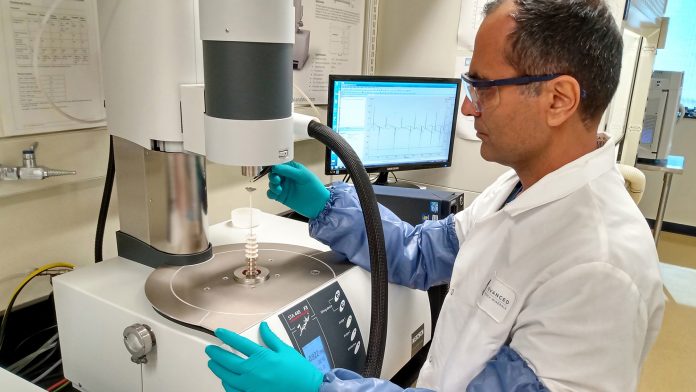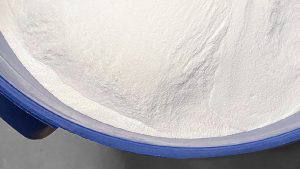Daniele Fregonese, SVP for Sales and Marketing at Advanced Energy Minerals, explains the benefits of the company’s SupALOX™ sustainably manufactured ultra-high purity alumina.
Advanced Energy Minerals (AEM) manufacture ultra-high purity alumina (HPA) at our full-scale production plant at Cap-Chat, Quebec, Canada, which we market under our SupALOX™ brand.
Powered by hydroelectricity, using our patent-protected and proprietary Chlorine Leach – Crystalline Purification (CLCP) production process and utilising a locally sourced feedstock, the Cap-Chat plant has an industry-leading low carbon footprint. It produces nearly zero waste and can deliver up to 99.999% pure alumina (5N HPA) at globally competitive prices. It is particularly well placed to supply North American and European markets.
We acquired the Cap-Chat plant from Orbite Technologies in 2020. It had previously been built with a design capacity of 1,000 tpa of HPA but encountered engineering shortcomings during commissioning. Having acquired it, we have re-engineered the plant to remove those shortcomings and have subsequently completed the plant’s commissioning successfully.
The CLCP process was developed at our Technical Development Centre (TDC) in Montreal. Equipped with C$8m worth of advanced laboratory equipment and staffed by highly qualified research engineers and scientists, the TDC gives us a comprehensive, in-house research and development capability to lead our process and product development activities. The process is suitable for manufacturing HPA from a range of aluminous feedstocks and is protected by a range of international patents. The TDC, its know-how and the patents were all acquired as a package with the Cap-Chat plant.
What are the uses of ultra-high purity alumina?
HPA is valued for its excellent properties in terms of chemical stability, very high melting point; high mechanical strength and hardness (particularly as sapphire); and good thermal conductivity but high electrical insulation. It takes on several crystalline structures, such as alpha (α), beta (β) and gamma (γ). The specific surface area of α-HPA is low, and it is very resistant to high temperature and is inert, having almost no catalytic activity. Whereas γ-alumina has excellent dispersion and a higher specific surface area, it is inert and provides high activity. It is more commonly used as a catalyst support and adsorbent.
HPA is generally marketed in either powder or pellet (compacted powder in a ‘puck’ shape) form, depending upon the end-use, as each application has different physical and chemical tolerances. The powder has a particle size typically measured in microns (μm); however, certain ultra-fine powders may be measured in nanometres (nm).
Pellets (or pucks) are used to manufacture synthetic sapphire and designed to maximise the HPA’s density. The equipment that melts the HPA into sapphire can maximise production volume from a single production run. Purity is also essential because any impurities may impact the transparency or conductivity of the sapphire produced and may also reduce the yield of continuous sapphire crystal. The primary uses for synthetic sapphire are as a substrate in semiconductors, particularly light-emitting diodes (LEDs), and in high-performance optical and photonic applications.
Powders have a range of uses in advanced ceramic applications (e.g., for additive manufacturing) and have growing uses in high-performance batteries, where HPA is:
- Already in well-established use as a ceramic coating to the polymer separator in lithium-ion batteries;
- Seeing emerging use as a coating to anodes and cathodes: and,
- Exhibiting potential uses in solid-state electrolytes.
Depending on the end-use application, powders need to be produced to a particular morphological specification. Particle size can be controlled both at the crystal-growing stage and via subsequent milling (although the latter requires careful control to avoid contamination by the grinding media).
Currently, demand for HPA for sapphire production, especially for its use in LED lighting, dominates the market. However, the demand from the battery sector is expected to grow rapidly on the back of the global transition to electric vehicles (EVs).
What is SupALOX™ high purity alumina?
We manufacture SupALOX™ high purity alumina as α-phase, typically 5N pure (99.999%) aluminium oxide (Al2O3), which we can then tailor to each customer’s specific requirements for:
- Particle size – as a powder in a range of particle size distributions, down to a minimum D50 of 200 nm;
- Densification – as sintered pucks to a maximum specific gravity of 3.8; and
- Doping – for example, for the manufacture of spinel.
SupALOX™ HPA’s 5N purity, measured across all significant impurities, is among the highest purity currently available in the market and is unmatched by all but very few existing suppliers.
The conventional process route for producing high purity alumina is the alkoxide process, which first reacts aluminium metal with an alcohol. It then reacts the resulting alkoxide with water to produce alumina. The aluminium metal feedstock is expensive and typically highly carbon-intensive. In a recent report, CICERO Shades of Green has indicated that the typical carbon footprint of HPA produced by the alkoxide process is 12.3 tCO2e/t HPA.
Our CLCP process route for manufacturing SupALOX™ HPA is very different, with our feedstock and energy supply being both competitively priced and having extremely low carbon footprints. In-house calculations, yet to be independently verified, indicate that the resulting carbon footprint of SupALOX™ HPA is less than 1.5 tCO2e/t HPA, i.e., less than 12% of the carbon footprint of HPA manufactured by the conventional alkoxide process route.
Hydrochloric acid, another essential input to our CLCP process, is recycled many times within the process before being discharged, predominantly in the form of aluminium chloride, which we sell as a by-product for use in the water treatment industry.
SupALOX™ ultra-high purity alumina, therefore, offers compelling benefits to users seeking alumina with leading-edge purity and environmental credentials.
Future research and developments for our CLCP process
We actively research and develop improvements and extensions to our CLCP process and product offering. Our activities are currently focused on three areas:
- Applying and developing learnings from the Cap-Chat plant to incorporate a range of process and value engineering improvements in our CLCP process. We recently completed a feasibility study for a second production plant located in the UK with financial support from the UK Government’s Automotive Transformation Fund. This work enabled us to advance this next-generation design substantially. It will inform our plans not just for the UK but also for expanding the Cap-Chat plant and establishing plants in other locations;
- Researching ways of augmenting our CLCP process to produce powders and suspensions of nano-sized (<10 nm) particles of HPA and other high purity compounds of aluminium, particularly for battery applications. We are partnering with a leading supplier of natural graphite active anode material as a part of this work; and
- Developing a new form of HPA, which is expected to offer significant productivity gains to manufacturers of synthetic sapphire.
This heavy emphasis on research and development supports our aim to become a leading, highly customer-focussed supplier of ultra-pure HPA and related industrial minerals delivered to the highest standards of environmental performance and social governance.
Please note, this article will also appear in the tenth edition of our quarterly publication












